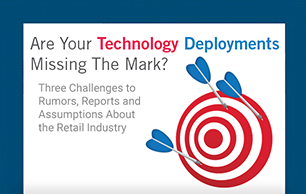With higher attendance than ever, the LPRC IMPACT Conference was abuzz with lively discussions of the latest technologies and their applications for Loss Prevention (LP) teams. For example, there was lots of discussion about RFID, an established technology with new implications for LP.
Offering source-to-store visibility of inventory from the vendor’s manufacturing plant to the time it exits the store and/or is returned, RFID provides tremendous insight into a product’s life. Using data from RFID tags, LP can see where potential mishandling, loss, fraudulent returns or other problems occurred. However, the original use case for RFID was not for loss prevention, but rather for inventory tracking, customer service and even marketing. Likewise, video used to fall nearly exclusively under the domain of the LP/Asset Protection team, and is now nothing short of critical to operations, marketing, merchandising and virtually every functional area of retail. These changes have been fast and extensive, as technologies are no longer selected for siloed purposes, but offer data of value across the board.
As these technologies blur the lines of “ownership,” the underlying challenge seems to be centered around the human element, the changes in how technologies are shared, specified and how LP collaborates with IT and other departments across the board.
At LPRC, a few tips came to light to help guide LP professionals in this brave new world of technology evaluation, selection and deployment, as part of the larger team.
Embrace multiple stakeholders
Independent and nimble, LP teams have grown accustomed to playing alone in the sandbox. As a result, one of the greatest changes for LP is getting used to collaborating with others. Expected to be self-sufficient in the past, now LP needs to pull in stakeholders from every area across the organization as well as external deployment and integration partners. Collaboration is key to evaluating technologies adequately that serve multiple purposes. LP simply needs to jump in, getting to know other stakeholders and sharing the use cases for these technologies when it comes to shrink reduction and asset protection.
Create roadmaps and ROI models
With today’s multi-functional technologies that offer value across the board, it’s critical to develop roadmaps and ROI models prior to selection and deployment. LP is used to trying to squeeze in technology purchases on tiny budgets. However, with broader use cases for technologies and collaboration across the organization, LP teams can benefit from working with other departments to access more funding for these technologies, making them more cost effective and delivering a stronger ROI. With growing use cases across the organization, LP can collaborate with other departments to develop ROI models and budgets for better technologies.
Together, stakeholders are more likely to select technologies that work with the unified platform and part of a larger ecosystem, rather than being slated for use by one particular department or for one, specific function. For this reason, roadmaps and use cases are extremely useful for truly planning technology use and deployment.
One of the most effective ways to work with both IT and executives to gain approval is to paint a picture of the value of the technology with roadmaps and ROI models.
Experience the technology prior to purchase
The LPRC has an innovation lab where you can go see, touch and experience the technology. This is extremely powerful for understanding how you can use the technology in your business and exactly what it can do. As a part of due diligence, it’s important to take advantage of this capability. Experience the technology first-hand to truly understand what it can do for you.
In short, LP can proactively embrace change in the way they are managing technology specification and implementation. Sharing of technologies is now the rule rather than the exception. A new era is calling for LP professionals who can collaborate with others, leverage new technologies, and communicate with effectiveness. Savvy LP professionals are becoming brokers of information to the entire organization.
The LPRC will continue studying RFID with its retail members in their collaborative new RFID Innovation Chain monthly call series. Please contact mike@lpresearch.org to learn more




